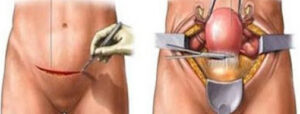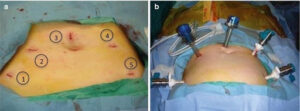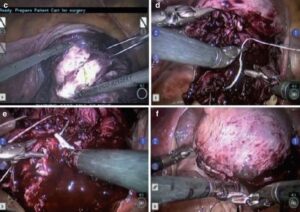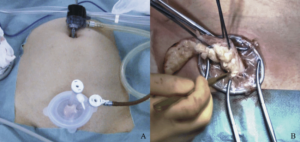I Just Found Out I Have Fibroids That Need Treatment. Should I Have Hysterectomy? Myomectomy? Or Embolization (UFE)?

If you have been diagnosed with symptomatic fibroids and you were offered surgical treatment, chances are you were told your only options are hysterectomy or myomectomy. Hysterectomy is the removal of the uterus even if it’s called partial hysterectomy or total hysterectomy. Myomectomy is the removal of one or many fibroids at the same time. It is impossible for myomectomy to remove all the fibroids you have. Small fibroids are ready to take over the blood supply diverted from the first surgical myomectomy and its just question of time before they show up again with symptoms sometimes more pronounced. In addition, we have seen patients who ended up with bad adenomyosis after these surgeries.
So How Are Hysterectomy Or Myomectomy Done?
OPEN SURGERY: The skin, fat, muscle and fascias are cut and direct conventional surgery is performed with instruments introduced into the belly for dissection cutting, irrigation, suction, suturing etc.

LAPAROSCOPIC SURGERY: Sometimes called in a fancy way “Robotic surgery” or “LAAM: Laparoscopic-assisted abdominal myomectomy” or LAAM-BUAO for Bilateral uterine artery occlusion” or “Dual port”. Well, to simplify things what really happens is that instead of one continuous incision line, several holes are made in the abdominal wall called access points/ports. Then the instruments still go inside the abdomen, come into contact with other organs, cuts and incisions are made which lead to scars.
A picture is worth a thousand words!!



Not so minimally invasive after all!
Now whether you undergo an open hysterectomy/myomectomy or a laparoscopic hysterectomy/myomectomy in the form of Dual port, LAAM, LAMM-BUAO or whatever the fancy names are, the instruments will cross into the abdomen, come into contact with other organs that have nothing to do with fibroids with a real risk of serious complications such as injuring the bladder, the bowel, the urinary system which may require additional surgical procedures to repair, incisions will be made to the uterus, scars and fibrous tissue will form. Let alone the risk of abscess and infection that comes with these traditional surgeries. But even with all these risks, your gynecologist will never commit to the following answer: “Your fibroids will not come back and new ones won’t develop” simply because there is a 62% chance they are coming back or new ones will form.
What’s more, once you sign up for a myomectomy, you will sign up for a possible hysterectomy and blood transfusions if things don’t go well while you are under anesthesia.
If everything goes without complications, now the road to recovery is another challenge and may take a long time.
Now compare the above procedures to the Uterine Fibroid Embolization, sometimes referred to as uterine artery embolization or UFE:
- It is the only truly minimally invasive procedure for fibroids. No cuts or incisions.
- Never touches any other organs inside the abdomen so no scars.
- There’s virtually zero risk of injury to any other organs since embolization is well controlled in experts’ hands.
- UFE takes one hour and you go home the same day.
- Recovery is only few days.
- All the fibroids you have will be treated once and for all regardless of number, size or location AND they are not coming back.
- You will be glad you choose this route😊
Video: https://youtu.be/XVO3q5bPytY https://youtu.be/9HLQh-VJfuU (CUT AT 1:46)
So why isn’t my gynecologist offering me embolization (UFE) as a treatment option? Check out our blog about myths your gynecologist is telling you about Embolization (UFE)?
AND
How does conventional surgery aka myomectomy and technology driven embolization affect my fertility?
Check out our blogs dedicated to these questions.


